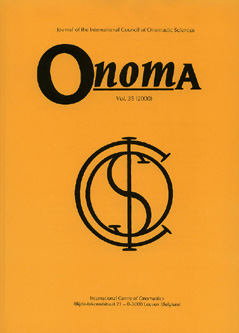 previous article in this issue previous article in this issue | next article in this issue  |

Preview first page |
Document Details : Title: A Contrastive analysis of contemporary Flemish and Polish Bynames Author(s): KALETA, Z. , VAN LANGENDONCK, W. Journal: Onoma Volume: 36 Date: 2001 Pages: 183-211 DOI: 10.2143/ONO.36.0.563283 Abstract : The analysis of a representative sample of contemporary Flemish and Polish dialectal material shows that the two main diachronic-semantic categories of bynames, namely those indicating origin and marital relationship on the one hand and those indicating characteristic properties of a person on the other are identical. Differences but also certain similarities are observed in the formal expression of the category of bynames indicating origin. A stark contrast is found in patterns indicating familial and local origin as well as marital relationship: analytic prepositional phrases consisting of van‘from’ plus a personal or local name prevail in Flemish dialects whereas synthetic suffixal bynames derived from personal or local names predominate in Polish dialects. Another difference in expressing familial origin and marital relationship concerns the application of the notion of possessivity. While in Polish this notion is widely utilized in both categories, in Flemish it is hardly marked. Similar patterns expressing familial origin in Flemish and Polish dialects are those with the genitive case. The most similar expressions are the ones in which both the preposition and the genitive collective/plural ending(s) occur, such as Flemish Rafle van Tjap-s ‘Rafle from the Tjaps family (coll.pl.)’ and Polish Bronek od Michalczyk-ów ‘Bronek from the Michalczyki family (coll.pl.)’. The most important difference between the Flemish and the Polish genitive expressing familial origin lies in the fact that in certain Flemish dialects the ending –(e)s denotes both descent from an individual parent and belonging to the whole family. By contrast, in the Polish area there is a clear opposition between the singular and the plural/collective genitive. The majority of characterizing bynames draw on appellatives in both languages, but in Polish diminutive appellatives are often used while in Flemish, diminutive forms are rare. We have come to the above conclusions by applying the diachronic-semantic framework to both Flemish and Polish bynames. This framework has allowed us to compare bynames from the viewpoint of their original meanings and motivations and to show the morpho-syntactic means that express these meanings. |
|


